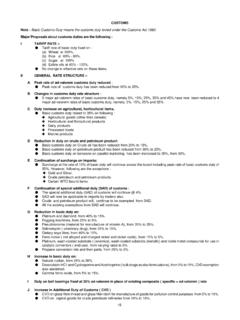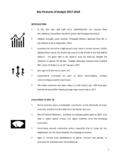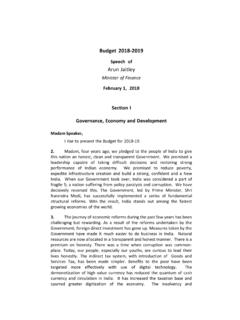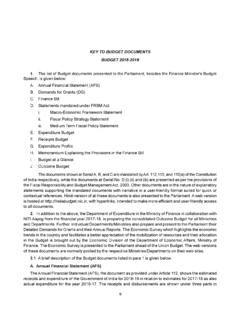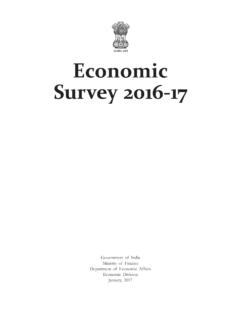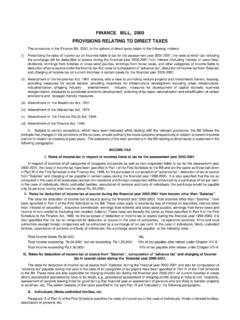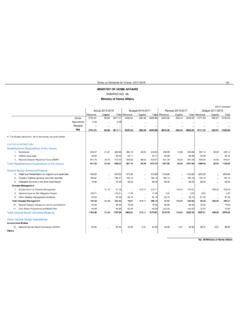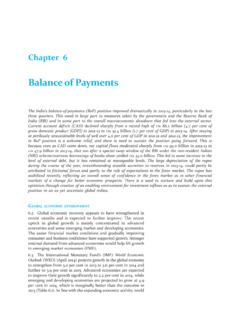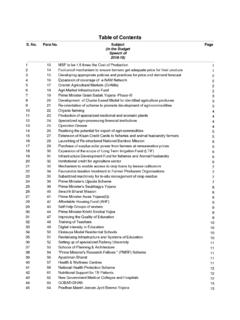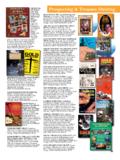Transcription of Economic Survey 2016-17 - indiabudget.gov.in
1 EconomicSurvey 2016-17 Government of IndiaMinistry of FinanceDepartment of Economic AffairsEconomic DivisionJanuary, 2017 CONTENTSC hapter Page Name of the interesting Facts about IndiaSECTION I: THE PERSPECTIVE1 Economic Outlook and Policy Challenges1 Introduction6 Global Context9 Review of Developments in 2016-1713 Outlook for 2016-1720 Outlook for 2017-1822 Other Issues22 Redistribution: Universal Basic Income (UBI) as a radical new vision23 Exchange rate policy: Vigilance and new ways of monitoring25 Trade Policy26 Climate Change and India27 Ensuring Women's Privacy30 India's Soon-to-Recede Demographic Dividend2 The Economic Vision for Precocious, Cleavaged India38 Introduction42 The Road to be Traversed46 Possible Explanations51 ConclusionSECTION II: THE PROXIMATE3 Demonetization: To Deify or Demonize?53 Introduction55 Background Facts59 Analytics61 Benefits62 Early Evidence for Potential Long Term Benefits66 Short Term Impact69 Impact on GDP76 Redistribution to the Government76 Markers of Success77 Maximizing Long Term Benefits, Minimizing Short-Term Costs4 The Festering Twin Balance Sheet Problem82 Introduction89Is the Strategy Sustainable?
2 94 What Needs to be Done?98 Conclusion5 Fiscal Framework: The World is Changing, Should India Change Too?105 Introduction106 India and the World: Flows108 India and the World: Stocks111 Conclusion6 Fiscal Rules: Lessons from the States113 Introduction115 Summary of the Fiscal Responsibility Legislation115 Assessment Methodology117 Impact on Deficits119 Off-Budget Expenditure120 Budget Process121 Assessment122 Lessons for Future Fiscal Rules7 Clothes and Shoes: Can India Reclaim Low Skill Manufacturing?128 Introduction128 Why Clothes and Shoes?132 Challenges136 Policy Response and Conclusions8 Review of Economic Developments140 Introduction142 Fiscal Developments144 Prices147 Monetary Management and Financial Intermediation151 India's Merchandise Trade152 Balance of Payments154 External Debt155 Outlook for the Economy for the Year 2017-18155 Agriculture and Food Management158 Industrial, Corporate and Infrastructure Sectors159 Services Sector160 Social Infrastructure, Employment and Human Development165 Climate Change9 Universal Basic Income: A Conversation With and Within the Mahatma173 Introduction173 The Conceptual/Philosophical Case for UBI174 The Conceptual Case against UBI175 Why Universalize?
3 182 How Can a UBI Overcome These Issues?182 Insurance against Risk and Psychological Benefits183 Improved Financial Inclusion186 Temptation Goods: Would a UBI Promote Vice?187 Moral Hazard: Would a UBI Reduce Labour Supply?187 The Way Forward195 ConclusionsSECTION III: THE PERSISTENT10 Income, Health and Fertility: Convergence Puzzles213 Introduction216 Finding 1: Income/Consumption Divergence Within India220 Finding 2: Health Convergence within India with Room for Improvement againstInternational Standard223 Finding 3: Fertility: Exceptional Performance223 Conclusions11 One Economic India: For Goods and in the Eyes of the Constitution231 Introduction233 Section 1: One India: Internal Trade in Goods233 Does India Trade More Than Other Countries?235 Relationship Between Interstate Trade and Manufacturing235 Patterns of Interstate Trade: Arms-length Trade237 Patterns of Interstate Trade: Intrafirm trade239Is Indian Interstate Trade Unusual?
4 Formal Evidence from a Gravity Model240 Explaining the puzzle: Why Does India Trade so Much?242 Conclusion243 Section 2: One India: Before the Law243 Introduction243 India's Constitutional Provisions and Jurisprudence245 Provisions in Other Countries246 Comparable WTO Law248 Conclusion12 India on the Move and Churning: New Evidence264 Introduction and Main Findings266 Baseline Census Data: Migration Levels and Growth267Re-estimating Migration: Two Time Periods, Two Data Sources, Two New Approaches277 Conclusion13 The 'Other Indias': Two Analytical Narratives (Redistributive and NaturalResources) on States' Development285 Introduction286 Impact of Redistributive Resources287 Redistributive Resource Transfers: Evidence from Indian States292 Impact of Natural Resources292 Natural Resources and Evidence from Indian States295 Conclusion14 From Competitive Federalism to Competitive Sub-Federalism: Cities as Dynamos300 Introduction301 Background302 Key Challenges306 Lessons from Across India309 Mobilising Resources314 ConclusionNOTESThe following figures/units are used in the Economic Survey :BCMbillion cubic metresBUbillion unitsMTmillion tonneslakh1,00,000million10 lakhcrore10 millionkgkilogramhahectareBblbillion barrels per litrebillion1,000 million/100 croretrillion1,000 billion/100,000 crore(v)AcknowledgementsThe Economic Survey is a result of teamwork and collaboration.
5 Contributions to the Survey from the Economic Divisionand Office of CEA include: Archana Mathur, Prasad, A. S. Sachdeva, Rohit K. Parmar, Negi, Rajasree Ray, AntonyCyriac, R. Sathish, Abdul Kareem, Ashutosh Raravikar, Nikhila Menon, Shweta, Mrityunjay Jha, Aakanksha Arora, RabiRanjan, Dipak Kumar Das, Vijay Kumar, M. Rahul, Abhishek Anand, Gaurav Jha, Kanika Wadhawan, Sonal Ramesh, VijayKumar Mann, Riyaz Ahmad Khan, Shobeendra Akkayi, Salam Shyamsunder Singh, Md. Aftab Alam, Pradyut Kumar Pyne,Narendra Jena, Sanjay Kumar Das, Parveen Jain, Subhash Chand, Rajesh Sharma, Amit Kumar Kesarwani, Mritunjay Kumar,Gayathri Ganesh, Tejaswi Velayudhan, Rangeet Ghosh, Josh Felman, Justin Sandefur, Dev Patel, Rohit Lamba, SiddharthEapen George, Sutirtha Roy, Shoumitro Chatterjee, Sid Ravinutala, Amrit Amirapu, M R Sharan, Parth Khare, Boban Paul,Ananya Kotia, Navneeraj Sharma, Kapil Patidar and Syed Zubair Husain Survey has greatly benefitted from the comments and insights of the Hon'ble Finance Minister Shri Arun Jaitley, whoalso authors a section in the Survey , possibly the first such contribution by a Finance Minister.
6 The Survey also sincerelyacknowledges the comments and inputs from the other Hon'ble Ministers including Shri M. Venkaiah Naidu, Shri SureshPrabhu, Shri Ramvilas Paswan, Shri Ananth Kumar, Shri Jagat Prakash Nadda, Shri Radha Mohan Singh, Smt. Smriti ZubinIrani, Shri Dharmendra Pradhan, Shri Piyush Goyal, Smt. Nirmala Sitharaman, Shri Jayant Sinha and the Ministers of Statefor Finance - Shri Santosh Kumar Gangwar and Shri Arjun Ram Survey has also benefitted from the comments and inputs from officials, specifically, Arvind Panagariya, Nripendra Misra,P K Mishra, Raghuram G Rajan, Urjit Patel, Ashok Lavasa, Shaktikanta Das, Hasmukh Adhia, Anjuly Chib Duggal, Neeraj KumarGupta, S Jaishankar, Amitabh Kant, T C A Anant, Vijay Kelkar, Y V Reddy, Ramesh Chand, A P Hota, Rita Teotia, Kapil Dev Tripathi,Rashmi Verma, M. Sathiyavathy, Simanchala Dash, Sangeeta Verma, Amarjeet Sinha, Sushil Chandra, Mohan Joseph, Ajay Tyagi,Dinesh Sharma,Najib Shah, Sushil Chandra, Rani Singh Nair, Nagesh Singh, M R Anand, T V Somanathan, Tarun Bajaj, BrajendraNavnit, Anurag Jain, Saurabh Garg, Prashant Goyal, Anand Jha, Dr.
7 Kumar V. Pratap, B V L Narayana, Arvind Mehta, Arbind Modi,Ashutosh Jindal, Alok Shukla, Amitabh Kumar, Hanish Yadav, Naveen Vidyarthi, Satya Srinivas, Michael Patra, Deepak Mohanty,Bipin Menon, Nanda Sameer Dave, Avneesh Kapoor, Virender Singh, Anurag Sehgal, Deepshikha Arora, Rajan Kumar, AkshayJoshi, Deepak Kumar, DPS Negi, Ram Reddy, Kanchan Dyuti Maiti, Verma, Saswat Rath, Shweta Tomar, Varun Dutt, NishaThompson, Thejesh G N, Jorge Coarasa, Sheena Chhabra, Owen K. Smith, Srnivas Kodali, Avinash Celestine, Aman Gupta,Pawan Bakshi, Manoj Alagarajan, Renana Jhabvala, Sarath Davala, Naveen Thomas, Rajesh Bansal, Arghya Sengupta, Rahul Basu,Basu, K P Krishnan,Nirmal Kumar, Prashant Kumar, Laveesh Bhandhari, Tilottama Ghosh, Bhartendu Pandey, Tisha Sehdev,Serene Vaid, Ranjeet Sinha, Kalpnath Bharadwaj, Praveen Kumar, Prakash Kumar, Sanjay Sinha, Yogesh, Todd Moss, CarolineFreund, Samantak Dash, Shishir Baijal, Sumit Shekhar and Savitri Devi, the GSTN team, the Data Meet team and the entire teamin the Finance Library.
8 And a number of external collaborators including Abhijit V Banerjee, Dani Rodrik, Devesh Kapur, PratapBhanu Mehta, Partha Mukhopadhyay, Nandan Nilekani, Surjit Bhalla, Himanshu, Chinmay Tumbe, Irudaya Rajan, Devesh Roy,Harish Damodaran, Guy Standing, S Sunitha, Manoj Aalagrajan, Sanjaya Kumar, Ashoka Mody, Shekhar Aiyar, Rammanohar Reddy,Sudipto Mundle, Suyash Roy, Rinku Murgai, Dipa Sinha, Milan Vaishnav, Manish Sabharwal, Jeremy Shapiro, Andreas Bauer,Saurabh Shome, Paul Cashin, HarshaVardhana Singh, Shyam Singh Negi, I S Negi, Rafeeq Ahmad, Sanjay Kumar, Aanchal Gupta,Harish Ahuja, V Rangarajan, Rohit Vohra, Tulsipriya Rajkumari, Siddharth Hari, Satya Poddar, Tarrung Kapur, Sajjid Chinoy,Neelkanth Mishra, Pranjul Bhandari, PetiaTopalova, Frederico Gil Sanders, Kartikeya Subramanian, Seher Gupta, Sahil Kini,Ashish Gupta, Kush Shah Srikanth Viswanathan, Anil Nair, Hari Menon, Sandhya Venkateswaran, Madhu Krishna, YaminiAtamvilas, Akali Muthu, Akhila Sivadas, Somnath Sen, Anjali Chikersal, Swapnil Sekhar, Rajeev Malhotra, Manoranjan Pattanayak,Ranen Banerjee, Dilip Asbe and Bhagesh from the above, various ministries, departments and organisations of the Government of India made contributionsin their respective sectors.
9 Able administrative support was given by S. Selvakumar, R P Puri, R K Sinha, N Srinivasan,V K Premkumaran, Gurmeet Bhardwaj, Pradeep Rana, Sadhna Sharma, Jyoti Bahl, Sushil Sharma, Manish Panwar, Sushma,Muna Sah, Suresh Kumar, Aniket Singh, Jodh Singh, Puneet, Ombir, R R Meena, Subhash Chand, Raj Kumar and otherstaff and members of the Economic Division and the Office of CEA. R B Aniyeri and his team of translators carriedout the Hindi translation. The cover page for the Survey was designed by Jacob George of George Design, Kochi, assistedby Vineeth Kumar. Viba Press Pvt. Ltd., Okhla undertook the printing of the English and Hindi version of the , the Economic Survey owes a huge debt of gratitude to the families of all those involved in its preparation for beingever so patient and understanding and for extending their unflinching support and encouragement throughout the Subramanian(Chief Economic Adviser)Ministry of FinanceGovernment of IndiaPREFACELast year, to its dismay, the Economic Division of the Ministry of Finance the authors of this EconomicSurvey discovered that there is indeed a higher form of flattery than imitation: brazen pirating, and thattoo on the most globally public of platforms, Amazon.
10 The anguish suffered by this violation of our intellectualproperty rights was more than offset by the gratitude we felt in achieving wide circulation for the strive to do better this year, risking that the Survey might be consigned to the ranks of popular year's Survey comes in the wake of a set of tumultuous international developments Brexit, politicalchanges in advanced economies-and two radical domestic policy actions: the GST and , the Survey needs to do full justice to all these short term developments, or else it risks beingHamlet without the Prince of Denmark. To deify or demonise demonetisation that is the difficult questionthe world is asking, to which the Survey tries to respond. The Survey affords an opportunity to work throughthe complexities of the analytics, empirics, and potential impacts of , however, offers little guide for assessment and prognostication, given the unprecedented natureof this action. And Economic models are notoriously unreliable in the face of structural breaks of the sortoccasioned by demonetisation.
